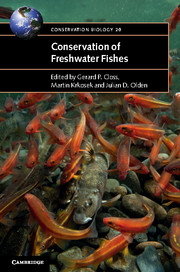Book contents
- Frontmatter
- Contents
- List of contributors
- Preface
- 1 Lost fishes, who is counting? The extent of the threat to freshwater fish biodiversity
- 2 Why are freshwater fish so threatened?
- 3 Climate change effects on freshwater fishes, conservation and management
- 4 Challenges and opportunities for fish conservation in dam-impacted waters
- 5 Chemical pollution
- 6 Multiple stressor effects on freshwater fish: a review and meta-analysis
- 7 Infectious disease and the conservation of freshwater fish
- 8 Non-indigenous fishes and their role in freshwater fish imperilment
- 9 Riparian management and the conservation of stream ecosystems and fishes
- 10 Fragmentation, connectivity and fish species persistence in freshwater ecosystems
- 11 Conservation of migratory fishes in freshwater ecosystems
- 12 Protecting apex predators
- 13 Artificial propagation of freshwater fishes: benefits and risks to recipient ecosystems from stocking, translocation and re-introduction
- 14 Freshwater conservation planning
- 15 Sustainable inland fisheries – perspectives from the recreational, commercial and subsistence sectors from around the globe
- 16 Understanding and conserving genetic diversity in a world dominated by alien introductions and native transfers: the case study of primary and peripheral freshwater fishes in southern Europe
- 17 Maintaining taxonomic skills; the decline of taxonomy – a threat to fish conservation
- 18 Synthesis – what is the future of freshwater fishes?
- Index
- References
16 - Understanding and conserving genetic diversity in a world dominated by alien introductions and native transfers: the case study of primary and peripheral freshwater fishes in southern Europe
Published online by Cambridge University Press: 05 December 2015
- Frontmatter
- Contents
- List of contributors
- Preface
- 1 Lost fishes, who is counting? The extent of the threat to freshwater fish biodiversity
- 2 Why are freshwater fish so threatened?
- 3 Climate change effects on freshwater fishes, conservation and management
- 4 Challenges and opportunities for fish conservation in dam-impacted waters
- 5 Chemical pollution
- 6 Multiple stressor effects on freshwater fish: a review and meta-analysis
- 7 Infectious disease and the conservation of freshwater fish
- 8 Non-indigenous fishes and their role in freshwater fish imperilment
- 9 Riparian management and the conservation of stream ecosystems and fishes
- 10 Fragmentation, connectivity and fish species persistence in freshwater ecosystems
- 11 Conservation of migratory fishes in freshwater ecosystems
- 12 Protecting apex predators
- 13 Artificial propagation of freshwater fishes: benefits and risks to recipient ecosystems from stocking, translocation and re-introduction
- 14 Freshwater conservation planning
- 15 Sustainable inland fisheries – perspectives from the recreational, commercial and subsistence sectors from around the globe
- 16 Understanding and conserving genetic diversity in a world dominated by alien introductions and native transfers: the case study of primary and peripheral freshwater fishes in southern Europe
- 17 Maintaining taxonomic skills; the decline of taxonomy – a threat to fish conservation
- 18 Synthesis – what is the future of freshwater fishes?
- Index
- References
Summary
INTRODUCTION
This chapter sets out to explore implications for conservation genetics as illustrated by impacts and patterns of introduced species with a special emphasis on southern European freshwater fishes, where alien fish globalisation has severely affected the genetic structure of native populations. Impacts to native species range from loss of genetic identity and fitness due to hybridisation to reduction in population and range sizes – and ultimately extinction – by predation, competition and habitat modification (Olden et al., 2010). Freshwater fishes are amongst the most imperilled faunas worldwide with over 30% of evaluated species considered threatened with extinction (Vié et al., 2009; Chapter 1) in spite of being often acknowledged as invaluable material to elucidate fundamental biological phenomena such as speciation in space and time.
Southern Europe – that part of the European continent south of the western–eastern divide represented by the main mountain ranges of the Pyrenees and the Alps and surrounding the Mediterranean Sea – hosts an astonishing number of endemic plant and animal species including freshwater fishes. The area is thus unanimously recognised as a biodiversity hotspot (Chapter 1). The roots of such diversity are to be found in the complex geological history of the area coupled with the effects of Quaternary ice ages. These events strongly affected central–northern Europe by extirpating most of their flora and fauna, leaving the area with a dramatically depleted biodiversity after each ice age cycle. However, the milder climatic conditions of southern Europe – even during ice age peaks – spared most of its species, allowing the persistence of many different lineages (Hewitt, 1999).
The diversity of freshwater fishes in southern Europe (peri-Mediterranean countries; Figure 16.1) is high and encompasses all four divisions used to classify freshwater fishes ecologically on the basis of their salt tolerance and physiological inability to survive in normal marine salt waters: primary, primary-like, secondary and peripheral (see Myers, 1938; Bianco, 1990; and Chapter 2 for a review of these categories). While primary forms are moderately salt-tolerant as they may stand salinity up to 13–15 ppm (Bianco & Nordlie, 2008), secondary and peripheral forms are euryhaline taxa including many diadromous migratory species and recently land-locked migratory taxa. In the peri-Mediterranean area this category includes, amongst others, trout, brook lampreys, killfishes and sticklebacks.
- Type
- Chapter
- Information
- Conservation of Freshwater Fishes , pp. 506 - 534Publisher: Cambridge University PressPrint publication year: 2015
References
- 4
- Cited by



